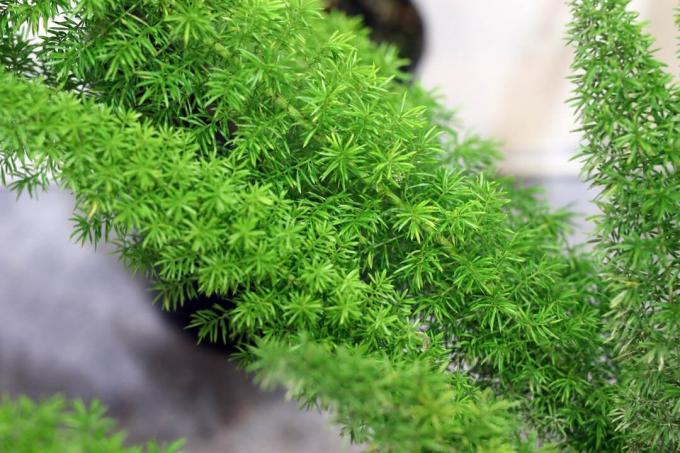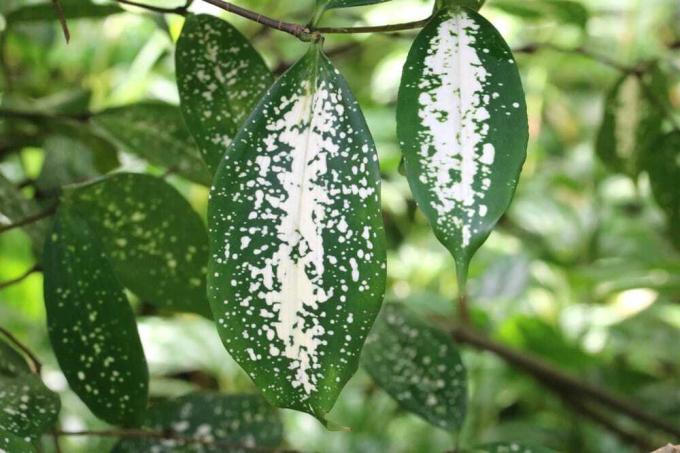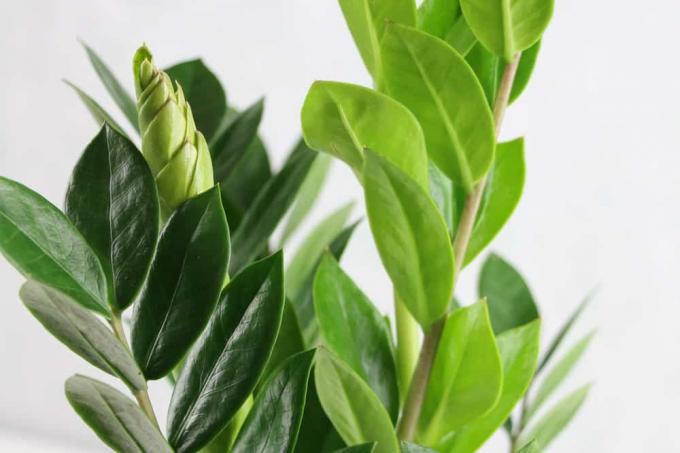

Table of contents
- Location
- substrate
- Pour
- Fertilize
- blending
- hibernate
- Diseases, pests and care errors
- Propagation of ornamental asparagus
- sorts
Ornamental asparagus can have many different orientations. Compact, climbing or high - the choice is large. You can find out here how the culture turns out from the location to propagation to overwintering.
Location
The location should be bright but not too bright. Morning sun and evening sun are ideal. Places facing east and west are therefore suitable as locations. However, blazing midday sun should be avoided. Because the plants react to this by shedding leaves or yellowing of the false leaves. However, shadow is also unfavorable. If the plant is too dark, the loss of foliage must also be expected. In addition, the following criteria are crucial when choosing the location:
- high humidity
- Protection against drafts
- Avoid temperatures below 13 °C
A notice:
Experience has shown that the bathroom and kitchen are particularly suitable for indoor plants. In summer, however, they can also be cultivated outdoors. On the south side, however, they should be covered.
substrate
The substrate used depends in part on the particular species of ornamental asparagus. In general, however, the following requirements should be met:
- permeable
- moist
- humorous
- moderately nutritious
Potting soil with an addition of coconut fibers or houseplant soil are therefore well suited.
Pour
The soil should always be slightly moist. This is especially true for the growing season from spring to late summer. Because if the root ball or the substrate around it dries out, the plant reacts with baldness.
When casting, there are also a few points to pay attention to. These include, among others:
- Avoid waterlogging
- submerged water is ideal
- Water should be at room temperature
- use soft water
It is best to place the entire pot in a bucket of water and wait until no more air bubbles rise from the soil. After that, the water should be able to drain away.

Suitable sources for the water are:
- stale tap water
- filtered water
- rainwater
- untreated water from aquariums and ponds
- soft tap water
It is good to bring the water to room temperature before watering. This can be achieved, for example, by leaving the bucket of water or a watering can in the room in question for several hours.
Hints:
A coaster is better than a planter. This allows water that escapes later to evaporate better. A drainage layer should also be installed.
Fertilize
Here the ornamental asparagus is particularly easy to care for. Fertilizer is applied every two weeks from spring to late autumn. Green plant fertilizer is suitable. This should be administered in liquid form with the irrigation water.
This avoids chemical burns on the roots as the nutrients are more evenly distributed throughout the substrate.
blending
A regular blending of ornamental asparagus is not necessary but possible. Potential reasons for this include:
- broken shoots
- infestation with pests
- Diseases
- discoloration
- balding
In these cases, the shoots are cut off just above the ground. Even if a complete radical cut has to be made, the plant usually grows back. However, the prerequisite is that she is otherwise healthy. It's also important to do it right.

A cutting tool that meets the following criteria is crucial:
- clean blades
- sharp edges
- quick drying
A sharp pair of scissors with disinfected blades is therefore ideal. In addition, the measure should be carried out in such a way that the cut surfaces can dry off in a short time.
hibernate
Overwintering ornamental asparagus is relatively easy. Ideal are:
- sufficient humidity
- bright location
- don't let it dry out
- Temperatures between 10 and 13 °C
A notice:
During the winter, the plant can also face south, since the sun's rays are not as intense then. In the spring after the winter, however, the blazing midday sun should be avoided again.
Diseases, pests and care errors
The main problems with ornamental asparagus relate to care errors and the resulting rot and mold. Diseases and pests, on the other hand, are rare. However, more common are:
loss of foliage
A plant of this variety tends to drop leaves if it is not kept sufficiently moist, or if it is too dark or too bright. A balding is therefore often due to a wrong location or errors in watering.
Mold
The plants are very sensitive to waterlogging. Rot and mold are the possible consequences. This can cause significant damage to the roots and lead to the death of the plant. A rescue is possible if
the condition is recognized and treated early. This requires the removal of the entire substrate and the affected parts of the plant.
discoloration
Yellow or brown discoloration is usually caused by dryness or excessive exposure to the sun. A change of location is therefore advisable.

Propagation of ornamental asparagus
Around spring you can propagate your ornamental asparagus by dividing the tubers with a sharp knife. Then you put them in pots with commercial potting soil and water them lightly. The same procedure is advisable if the space in the previous pot is no longer sufficient. The further care corresponds to that of the older plants.
The ornamental asparagus can also be propagated by seeds. There is a comprehensive guide on this topic here: Properly multiply ornamental asparagus.
sorts
Ornamental asparagus can be found in numerous varieties and cultivated forms. However, the following are particularly popular in Europe:
- Asparagus densiflorus
- Asparagus setaceus obsolete also known as Asparagus plumosus
- Asparagus sprengeri
They differ primarily in appearance. Asparagus densiflorus is the umbrella term for the Sprengeri and Meyeri varieties. Asparagus sprengeri is extremely robust and can develop hanging shoots up to one meter long. It is therefore ideal for culture in a traffic light.
Asparagus setaceus is also known as Asparagus plumosus and fern ornamental asparagus. It is reminiscent of a fern and also proves to be resilient.
 garden editorial
garden editorial I write about everything that interests me in my garden.
Learn more about indoor plant dictionary

Easy-care office plants - 18 plants for the office
If you have the opportunity to make your office a little more personal, you often use office plants because they have several good properties. You can find out which indoor plants are suitable here.

20 plants for children's rooms: non-toxic and easy to care for
Decorative plants are part of the design of the children's room. Plants in their own room give the offspring a comprehensive insight into the care of the plants, even if they are easy to care for. It is important when choosing plants that you choose non-toxic species.

Pruning & branching Money Tree, Crassula ovata
The money tree proves to be well tolerated by pruning. With targeted cuts, it can be raised to become a standard tree or formed into a bonsai. There are no limits for your creativity. The plant tolerates rejuvenation cuts as well as educational cuts or the radical removal of all shoots.

Dragon Tree, Dracaena surculosa: Care A – Z
Dracaena surculosa is a species of dragon tree popular for its fresh green and brightly mottled leaves. In contrast to the typical dragon tree, this one is more reminiscent of a bamboo because of its thin, branched stalks. But that is exactly what makes it so decorative.

10 useful indoor plants for a healthy indoor climate
Indoor plants transform a room into an oasis of well-being. They are decorative and healthy at the same time. They help to improve the room climate by reducing the concentration of carbon dioxide, optimizing the air humidity and binding pollutants from furniture and carpets. Which houseplants are recommended?

Is the lucky feather / Zamioculcas poisonous? Advice for children and cats
The lucky feather is popular because it just keeps growing without much attention. This houseplant, which comes from Africa, develops so beautifully that everyone would like to have it. But one thing to note: it is mildly toxic.

